Simple Summary
In clinical settings, some cases with hepatocellular carcinoma (HCC) demonstrate negativity in both alpha-fetoprotein (AFP) and des-gamma-carboxyprothrombin (DCP). Most are small and early-stage hepatocellular carcinomas (HCCs). This study aimed to investigate the characteristics and prognosis of AFP (<20 ng/mL) and DCP (<40 mAU/ml) double-negative HCC (DNHC) in higher BCLC stages. We confirmed that 120 of 374 patients (32.1%) were DNHC, and 17 (14.7%) were in higher stages (BCLC-B, C, and D). In higher-stage HCC, there was no difference in BCLC staging; however, there were significantly more cases under TNM Stage III in DNHC (71.0% vs. 41.4%, p = 0.026). This is due to the tumor size, which can influence treatment. Curative locoregional therapy was dominantly applied in DNHC (p = 0.022). Therefore, survival was significantly better in DNHC (p = 0.027).
Abstract
Alpha-fetoprotein (AFP) and des-gamma-carboxyprothrombin (DCP) are widely used as tumor markers to diagnose hepatocellular carcinoma (HCC). Some advanced HCCs demonstrate neither AFP nor DCP. This study investigated the characteristics and prognosis of AFP (<20 ng/mL) and DCP (<40 mAU/ml) double-negative HCC (DNHC) in higher-stage HCC. Between April 2012 and March 2022, 419 consecutive patients were enrolled with newly diagnosed HCC and 372 patients were selected that were diagnosed by histopathology and/or imaging. AFP-negative, DCP-negative, and double-negative HCC were identified in 262 patients (70.4%), 143 patients (38.2%), and 120 patients (32.3%), respectively. In higher-BCLC stages (BCLC-B, C, and D), 17 patients (14.7%) were DNHC. Although there was no difference in BCLC staging, there were more cases under TNM Stage III in DNHC (71.0% vs. 41.4%, p = 0.026). The median maximum tumor diameter was smaller in DNHC [3.2 (1.8–5.0) vs. 5.5 (3.5–9.0) cm, p = 0.001] and their median survival time was significantly better, even in higher-stage HCC [47.0 (24.0–84.0) vs. 19.0 (14.0–30.0) months, p = 0.027). DNHC in higher-BCLC stage HCC is independent of BCLC staging, characterized by a tumor diameter < 5 cm, and is treatable with a good prognosis.
1. Introduction
Primary liver cancer was the third leading cause of cancer death worldwide in 2020 with approximately 830,000 deaths according to GLOBOCAN 2020 data [1]. Hepatocellular carcinoma (HCC) comprises 75–85% of primary liver cancers. Alpha-fetoprotein (AFP) is the most used serum biomarker for diagnosing and monitoring HCC. Bergstrand and Czar identified AFP as a new fraction of alpha globulins in human fetal serum in 1956 [2]. Abelev discovered the relationship between AFP and hepatoma in 1963 [3]. In 1964, Tatarinov reported the first case in which the serum AFP levels were elevated in the sera of a liver cancer patient [4]. However, not all HCCs secrete AFP, and 40–46% of HCC patients reportedly remain AFP-negative (<20 ng/mL) [5,6,7].
A large-scale study demonstrated that an AFP-negative (<20 ng/mL) rate was found in 52.2% (262/502) of patients with small HCCs (<3 cm) and in 53.5% (51/95) of patients at TNM Stage I [6]. In addition, AFP may be elevated in cases of cirrhosis or hepatitis [8,9,10]. Therefore, AFP has a low specificity [11,12]. The optimal cut-off is still controversial [13,14]. In 1984, Liebman et al. reported an elevated plasma des-gamma-carboxyprothrombin (DCP), also known as a prothrombin molecule that is induced by vitamin K absence (PIVKA II), in 67% of patients with HCC [15]. Subsequently, other researchers reported that DCP is elevated in around 50–60% of patients with HCC and 15–30% of patients with HCC < 3 cm [16,17,18,19]. DCP is reportedly associated with portal vein invasion and poor prognosis [20,21]. Moreover, lens culinaris agglutinin-reactive fraction of AFP (AFP-L3) is now available to complement or replace AFP in diagnosing HCC [22,23]. It is particularly useful in early HCC < 2 cm because of its high specificity [24].
AFP and DCP are independent of one another [21]. Therefore, the combination of AFP and DCP may improve detection rates [25,26,27,28,29,30]. However, there are cases of AFP- and DCP-negative HCCs. Pan et al. recently reported a large-scale analysis of prognostic values of AFP and DCP in HCC and found that 12.9% of HCCs were both AFP- and DCP-negative (defined as AFP < 25 ng/mL and DCP < 40 mAU/mL) [31]. In the study, 57.7% (218/378) were BCLC-A in the AFP- and DCP-negative group. Miyaaki et al. indicated 35% (39/110) were AFP-L3 and DCP double-negative, and Toyoda et al. found 23.3% (159/685) were AFP, AFP-L3, and DCP triple-negative HCCs which were smaller than the others [32,33]. From these reports, the biomarker-negative cases consist of relatively small, early-stage HCC. These cases are the “upcoming HCCs” that cannot produce biomarkers because they are still small and in the earlier clinical stages. There may be a biomarker sensitivity issue and a lead time effect. However, we have experienced some advanced HCCs that can produce biomarkers that demonstrate neither AFP nor DCP. AFP and DCP double-negative HCC (DNHC) in higher stages may differ from DNHC in the earlier stages. Here, we aimed to investigate the characteristics and prognosis of DNHC in the higher stages.
2. Patients and Methods
This was a single-center, retrospective, observational study involving 417 patients from our hospital that were diagnosed with HCC that examined AFP and DCP at baseline levels between April 2012 and March 2022. Patients who took warfarin, vitamin K, or antibiotics were excluded because they would influence the DCP levels. The diagnosis was based on histopathology in 172 patients. Among the patients whose histopathology was unavailable, we selected only those that were diagnosed with typical HCC according to LR ≥ 4 (arterial phase hyperenhancement) on the CT/MRI Liver Imaging Reporting and Data System LI-RADS) v2018 [34]. Finally, there were 372 eligible patients (Figure 1). In this study, higher-stage HCC included the intermediate (B), advanced (C), and terminal (D) Barcelona Clinic Liver Cancer (BCLC) stages [35]. TNM was staged according to the UICC eighth edition [36]. DNHC was defined as both AFP-negative (<20 ng/mL) and DCP-negative (<40 mAU/ml).
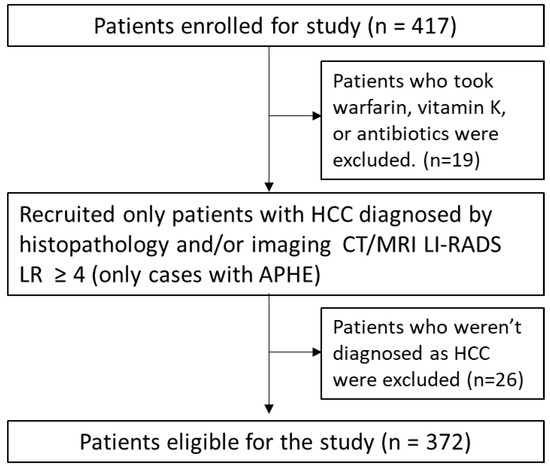
Figure 1.
Flowchart of patient selection. Initially, 417 patients with HCC were enrolled, but 19 were excluded for taking warfarin or antibiotics. Only patients with HCC that was diagnosed by histopathology and/or imaging were selected, and 26 patients were excluded. Finally, 372 patients were selected for this study. LI-RADS, Liver Imaging Reporting and Data System; APHE, arterial phase hyperenhancement.
Statistical Analysis
Welch’s t-test or chi-square test was applied to compare the two independent groups. Spearman’s correlation coefficient (shown as rS) was used for evaluating the correlation between two variables. The cumulative survival rate was calculated by the Kaplan–Meier method, and significant differences between the two groups were calculated using the log-rank test. Cox proportional hazards regression analysis was applied to evaluate the survival factors. All statistical tests were performed using StatFlex (Windows ver. 7.0; Artech, Osaka, Japan). Values are expressed as the mean ± SD or median (interquartile range). Median survival time (MST) (95% confidence interval) was used for the survival analysis. Statistical significance was set at p < 0.05.
3. Results
3.1. Patient Characteristics
Patient characteristics are shown in Table 1. We enrolled 372 patients [283 men, 89 women, 71.4 ± 10.4 years] in this study. The causes of their liver diseases included the hepatitis B virus (HBV) (n = 83), hepatitis C virus (HCV) (n = 96), HBV+HCV (n = 2), alcohol (n = 110), non-alcoholic fatty liver disease (NAFLD)(n = 18), and other causes (n = 63). A total of 199 patients had chronic hepatitis and 173 had cirrhosis. There were 115, 51, and 7 patients that were classified into Child–Pugh classes A, B, and C, respectively. There were 92, 164, 52, 54, and 10 patients that were classified into BCLC-0, -A, -B, -C, and -D, respectively. A total of 304 cases were classified as typical HCC (10 LR-4 and 354 LR-5) by enhanced CT/MRI. Of the patients who had a biopsy or resection, there were 58, 103, and 11 cases of well-, moderate-, and poorly-differentiated HCC, respectively. A total of 23 patients (6.2%) were AFP single-positive, 142 (38.2%) were DCP single-positive patients, and 87 (23.4%) were double-positive (DPHC) patients. The median duration of follow-up was 32.0 (13.0–59.0) months.

Table 1.
Patient characteristics.
A total of 262 patients (70.4%) were AFP-negative HCC (ANHC) and 143 patients (38.2%) were DCP-negative HCC (DCPNHC). There were 120 patients (32.3%) that were DNHC. In higher-stage HCC (n = 116), 50 patients (43.1%) were ANH, 20 patients (17.2%) were DCPNHC, and 17 patients (14.7%) were DNHC (Figure 2).
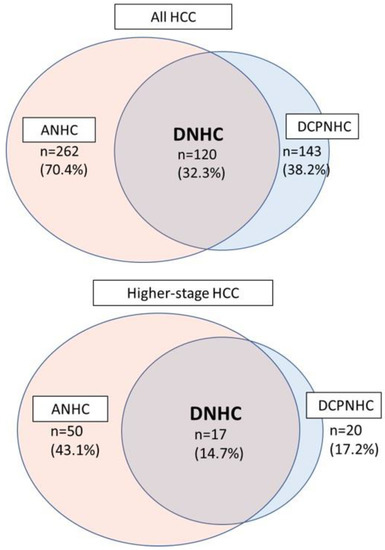
Figure 2.
HCC tumor marker negativity. Of all the patients with HCC (n = 372), 262 (70.4%) were ANHC, and 143 (38.2%) were DCPNHC. DNHC included 120 patients (32.3%). In higher-stage HCC patients (n = 116), 50 patients (43.1%) were ANHC, 20 patients (17.2%) were DCPNHC, and 17 patients (14.7%) were DNHC.
3.2. Characteristics of Patients with DNHC
Patients with DNHC were more likely to have well-differentiated HCC (51.9 vs. 25.8%, p = 0.010), very early and early stage (BCLC-0/A) (82.5 vs. 61.5%, p < 0.001), and lower TNM stages (IA/B and II) (95.8% vs. 75.4%, p < 0.001) compared to other groups (Table 2).

Table 2.
Comparison between patients with DNHC and other groups.
3.3. DNHC in Higher-BCLC Stage HCC
A total of 116 patients were classified as higher-BCLC stage HCC (BCLC-B, C, and D). In higher-stage HCC, 17 patients (14.7%) (10, 6, and 1 in BCLC-B, C, and D, respectively) were DNHC. Comparing DNHC patients with others in the higher-stage HCC, well-differentiated HCC was relatively higher in DNHC (p = 0.090). There was no difference in BCLC staging, the Up to 7 criteria, and Kinki criteria; however, there were more cases under TNM Stage III in DNHC (71.0% vs. 41.4%, p = 0.026). There was no statistical difference in the vascular invasion between DNHC and the other groups. The median maximum tumor diameter of DNHC was smaller than the other tumors [3.2 (1.8–5.0) vs. 5.5 (3.5–9.0) cm, p = 0.001] (Figure 3). Therefore, locoregional therapy [radiofrequency ablation (RFA), resection, trans-arterial chemoembolization (TACE), and stereotactic body radio therapy (SBRT)] was selected more frequently in the DNHC patients (p = 0.022). Patients with DNHC were more likely to achieve a complete response to the first treatment (p = 0.021) (Table 3).
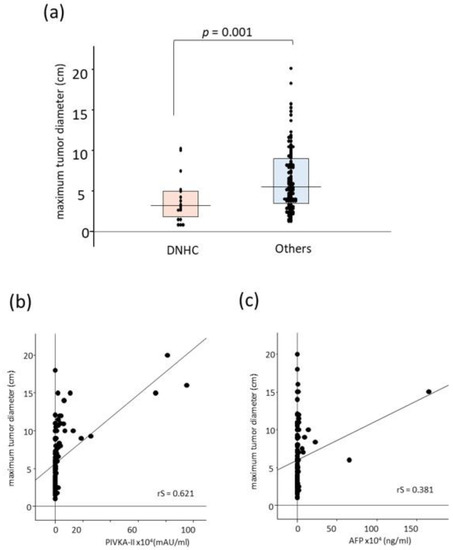
Figure 3.
The difference in the maximum tumor diameter and correlation with tumor markers in higher-stage HCCs. (a) The median maximum tumor diameter of DNHC was smaller than the other tumors [3.2 (1.8–5.0) vs. 5.5 (3.5–9.0) cm, respectively, p = 0.001]. Tumor size was moderately correlated with (b) DCP levels (rS = 0.621) rather than (c) AFP (rS = 0.381). AFP, alpha-fetoprotein; DCP, des-gamma-carboxyprothrombin; DNHC, double negative HCC; HCC, hepatocellular carcinoma.

Table 3.
Comparison between DNHC and the other groups in higher-stage HCCs.
3.4. Survival Analysis
We analyzed the survival of the whole dataset according to the BCLC staging. Survival was well stratified by the BCLC staging [ 0 vs. A, p < 0.001; A vs. B, p < 0.001; B vs. C, p = 0.022]; however, there was no statistical difference between BCLC-C and D (Figure 4a). The one, three, and five -year overall survival (OS) rates of each stage were 97.7%, 92.3%, and 76.5%, respectively, in BCLC-0; 91.0%, 72.9%, and 40.1%, respectively, in BCLC-A; 82.3%, 41.7%, and 24.0%, respectively, in BCLC-B; 56.9%, 29.4%, and 16.6%, respectively, in BCLC-C; and 40.5%, 0.0%, and 0.0%, respectively, in BCLC-D.
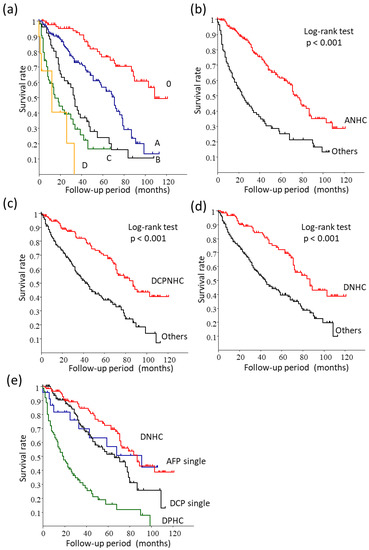
Figure 4.
Survival analysis. (a) BCLC staging for all patients. It was well stratified (inter-group statistical differences are p < 0.001, except for B vs. C; p = 0.022, B vs. C; p = 0.028, B vs. D; p = 0.005, and C vs. D; n.s.). (b) Comparison between ANHC and the other patient groups. The survival rate of the patients with ANHC was significantly better than the other patients (p < 0.001). (c) Comparison of DPCNHC and the other patient groups. The survival rate of the patients with DCPNHC was significantly better than the other patients (p < 0.001). (d) Comparison between DNHC and the other patients. The survival rate of the patients with DNHC was significantly better than the other patients (p < 0.001). (e) There was no difference between DNHC and AFP single-positive cases. DNHC cases demonstrated a substantially better prognosis than DCP single-positive cases (p < 0.001) and DPHC cases (p < 0.001).
The MST of patients with ANHC was significantly better than the other groups [73.0 (67.0–87.0) vs. 24.0 (16.0–34.0) months, respectively, p < 0.001) (Figure 4b). The MST of the patients with DCPNHC was significantly better than the other groups [87.0 (71.0–not reached) vs. 42.0 (34.0–51.0) months, respectively, p < 0.001] (Figure 4c). The MST of patients with DNHC was significantly better than the other groups [87.0 (71.0–not reached) vs. 45.0 (35.0–57.0) months, respectively, p < 0.001) (Figure 4d). The one, three, and five -year overall survival (OS) rates were 96.6%, 84.3%, and 72.1%, respectively, for DNHC and 80.2%, 56.5%, and 39.6%, respectively, for the other groups. There was no difference between DNHC and AFP single-positive cases. DNHC demonstrated a significantly better prognosis than DCP single-positive cases [87.0 (71.0–not reached) vs. 66.0 (46.0–78.0) months, respectively, p < 0.001) and DPHC [19.0 (13.0–27.0) months, p < 0.001) (Figure 4e).
In higher-stage HCC (BCLC-B, C, and D), the MST of the patients with ANHC was significantly better than the other groups [39.0 (32.0–55.0) vs. 14.0 (8.0–19.0) months, respectively, p < 0.001) (Figure 5a). The MST of the patients with DCPNHC was not statistically different from the other patient groups [42.0 (19.0–55.0) vs. 20.0 (14.0–30.0) months, respectively, p = 0.087) (Figure 5b). The MST of the patients with DNHC was significantly better than the other groups [47.0 (24.0–84.0) vs. 19.0 (14.0–30.0) months, respectively, p = 0.027) (Figure 5c). The one, three, and five -year OS rates were 94.1%, 66.8%, and 22.9%, respectively, for the DNHC group and 63.3%, 26.7%, and 18.9%, respectively, for the other groups.
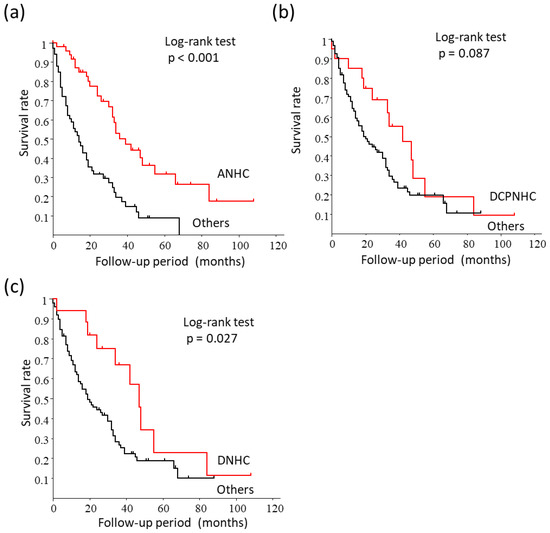
Figure 5.
Survival analysis in higher-stage HCC (BCLC-B, C, and D). (a) Comparison between ANHC and the other patient groups. The survival rate of the patients with ANHC was significantly better than the other groups (p < 0.001). (b) Comparison between DCPNHC and the other groups. There was no difference in survival between DCPNHC and the other patient groups (p = 0.087). (c) Comparison between DNHC and the other patients. The survival rate of the patients with DNHC was significantly better than the other groups (p = 0.028).
We then performed a Cox proportional hazards regression analysis, including age, sex, previously proven factors that are associated with HCC survival (Up to 7 criteria IN, Child–Pugh scores, and BCLC stage), and DNHC. The Kinki criteria was excluded because the Up to 7 criteria and Child–Pugh scores were already included in the criteria. Age, BCLC-stage, and Child–Pugh scores increased the relative risk for the survival of higher-stage HCC. The Up to 7 criteria IN and DNHC decreased the RR (Table 4) (Figure 6). DNHC was also an independent factor that was associated with the survival of higher-stage HCC.

Table 4.
Cox proportional hazards regression analysis of factors that were associated with OS in higher-stage HCC.
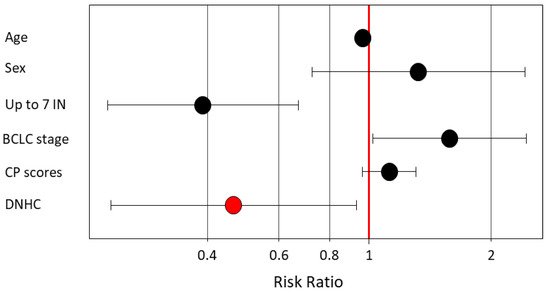
Figure 6.
Multivariate analysis for factors that were associated with the OS of higher-stage HCC. Age, BCLC-stage, and Child–Pugh scores increased RR. Up to 7 criteria IN and DNHC decreased the RR. BCLC, Barcelona Clinic Liver Cancer; CP, Child–Pugh; DNHC, double negative HCC.
4. Discussion
This study demonstrated that the incidence of DNHC was 14.7% in higher-stage HCC. In higher-stage HCC, there was no difference in BCLC staging between DNHC and the other groups. However, well-differentiated HCC was relatively higher and there were significantly more cases under TNM Stage III in DNHC, which affected the treatment choice. Locoregional therapy (RFA, Resection, TACE, and SBRT) was selected in cases of DNHC. Therefore, survival was significantly better in DNHC, even in higher-stage HCC.
It has long been reported that ANHC (<20 ng/mL) is a distinct entity of lower Edmondson–Steiner grade (Stage I and II) and demonstrates a favorable long-term prognosis [6,7,37]. An experimental study demonstrated that AFP has a regulatory role in angiogenesis and cell invasion during liver cancer development. AFP is actively involved in tumor progression [38]. ANHC (<20 ng/mL) is found in 30%-40% of advanced (TNM Stage III, IV) HCC patients [6, 7]. In our study, the incidence of ANHC in advanced HCC was consistent with other reports (31.3 % in TNM stage ≥ III and 32.3% in BCLC-C and D). The prognosis was significantly better than the other groups. In the molecular-targeted therapies for advanced HCC, ramucirumab is the only therapy that is defined by the baseline AFP level (≥400 ng/mL) according to the REACH2 trial [39]. Cases with AFP < 400 ng/mL originally had a better prognosis, which may be why ramucirumab could not improve OS compared with the placebo in the REACH trial [40]; locoregional therapy may be applied in these cases. DCPNHC was found in 34–64.9% of cases, and the recurrence-free survival and prognosis were better than in patients with higher DCP [18,19,20,21,33,41]. In our study, the incidence and prognosis were consistent with other reports.
Pan et al. indicated that DNHC had the best OS [31]. However, their data contained data on early-stage tumors; therefore, the “lead time effect” is inevitable. Interestingly, in our study, DNHC still demonstrates a better prognosis than the others, even in higher-stage HCC. The difference is not induced only by the “lead time effect.” Our results indicate that DNHC in higher-stage HCC had a relatively good histological appearance and was under TNM Stage III. It implies HCC heterogeneity in BCLC-B, C, and D. Kudo et al. proposed the “Kinki Criteria” for the subclassification of BCLC-B [42]. They classified BCLC-B into B1 to B3 by CP scoring, Milan criteria, and Up-to-7 criteria. However, in our study, there were no statistical differences in the BCLC-B subgroups. Differences seem to originate from the maximum tumor diameter. The diverging point would be 5 cm as T2 and T3 are divided by 5 cm in TNM staging [36]. The maximum tumor diameter was moderately correlated with DCP levels rather than AFP. Many reports have demonstrated that the tumor diameter increases DCP-positive rates [21,33,43]. Nakamura et al. indicated that the ROC area of DCP was significantly larger than that of AFP in tumors that were greater than 5 cm in diameter [44]. Tsugawa et al. also reported that DCP has predictive power for tumors > 5 cm [45]. Pan et al. also demonstrated that most of their DNHC (defined as AFP < 25 ng/mL and DCP < 40 mAU/mL) were smaller than 5 cm [31].
Multivariate analysis demonstrated DNHC is an independent factor for OS of higher-stage HCC. Tumor marker levels are not included in any criteria. However, our study implies that considering the “negativity” of tumor markers should be beneficial in determining treatment and is closely related to the survival of higher-stage HCCs.
In the clinical practice guidelines of HCC by the European Association for the Study of the Liver (EASL), the American Association for the Study of Liver Diseases (AASLD), and the Asian Pacific Association for the Study of the Liver (APASL), biomarkers were mainly discussed in the vein of early detection [46,47,48]. The prognostic aspect of the biomarkers was not mentioned. These guidelines indicated the limited ability of the AFP for early detection of HCC and discussed how to increase the accuracy for detection. They also introduced some novel biomarkers, such as glypican 3 [49], Golgi protein 73 [50], osteopontin [51], circulating cell-free DNA [52], and microRNAs [53]. These markers are under active investigation; however, none have been approved for clinical use. These novel biomarkers might be useful for DNHC in higher-stage HCC.
The difficulty in defining biomarkers that are specific for HCC cells is due to its complex genomic landscape with extensive intratumor and inter-tumor heterogeneities. Meanwhile, an emerging concept is that an interplay between viral infection and host genetic background is crucial for maintaining virome homeostasis or causing human disease [54]. Lui et al. demonstrated how viral infection history, obtained using human blood samples and VirScan analysis of antiviral antibodies, can be used to detect HCC in at-risk patients prior to clinical cancer diagnoses [55]. However, it cannot be applied to increasing non-viral HCC. The challenge of biomarker discovery continues.
Our study has some limitations. It was a small-size, single-center, retrospective observational study. A future large-scale prospective study is warranted. A biopsy was performed in only half of the patients. However, noninvasive imaging plays a key role in the diagnostic and therapeutic strategy for HCC. LI-RADS, used in this study, demonstrated excellent diagnostic accuracy for HCC in a systematic review [56]. Moreover, we only included cases with arterial phase hyperenhancement to achieve higher accuracy.
5. Conclusions
In this study, our results demonstrate that DNHC is a distinct entity that is independent of BCLC staging and may provide a better prognosis at any stage. DNHC in higher-stage HCC was smaller and curative locoregional therapy could be applied, resulting in a better prognosis.
Author Contributions
Conceptualization, T.S. (Takaaki Sugihara) and T.N.; methodology, T.S. (Takaaki Sugihara) and T.N.; Investigation; T.K., S.I., Y.H., T.S. (Takuki Sakaguchi), Y.M., T.N. and T.S. (Takaaki Sugihara); writing—original draft preparation, T.S. (Takaaki Sugihara); writing—review and editing, T.N., H.K., T.O., T.T., T.M. and N.Y.; supervision, H.I. All authors have read and agreed to the published version of the manuscript.
Funding
This research received no external funding.
Institutional Review Board Statement
The study protocol was approved by the Institutional Review Board of our institute (1610A127) under the guidelines of the 1975 Declaration of Helsinki.
Informed Consent Statement
We applied the opt-out method to obtain consent for this study.
Data Availability Statement
No new data were created or analyzed in this study; data sharing is not applicable to this article.
Conflicts of Interest
The authors declare no conflict of interest.
References
- Sung, H.; Ferlay, J.; Siegel, R.L.; Laversanne, M.; Soerjomataram, I.; Jemal, A.; Bray, F. Global Cancer Statistics 2020: GLOBOCAN Estimates of Incidence and Mortality Worldwide for 36 Cancers in 185 Countries. CA Cancer J. Clin. 2021, 71, 209–249. [Google Scholar] [CrossRef]
- Bergstrand, C.G.; Czar, B. Demonstration of a New Protein Fraction in Serum from the Human Fetus. Scand. J. Clin. Lab. Investig. 1956, 8, 174. [Google Scholar] [CrossRef]
- Abelev, G.I.; Perova, S.D.; Khramkova, N.I.; Postnikova, Z.A.; Irlin, I.S. Production of Embryonic Alpha-Globulin by the Transplantable Mouse Hepatomas. Transplantation 1963, 1, 174–180. [Google Scholar] [CrossRef]
- Tatarinov, Y.S. Detection of Embryo-Specific Alpha-Globulin in the Blood Sera of Patients with Primary Liver Tumour. Vopr. Med. Khimii 1964, 10, 90–91. [Google Scholar]
- Baig, J.A.; Alam, J.M.; Mahmood, S.R.; Baig, M.; Shaheen, R.; Sultana, I.; Waheed, A. Hepatocellular Carcinoma (HCC) and Diagnostic Significance of A-Fetoprotein (AFP). J. Ayub Med. Coll. Abbottabad 2009, 21, 72–75. [Google Scholar]
- Farinati, F.; Marino, D.; De Giorgio, M.; Baldan, A.; Cantarini, M.; Cursaro, C.; Rapaccini, G.; Del Poggio, P.; Di Nolfo, M.A.; Benvegnù, L.; et al. Diagnostic and Prognostic Role of α-Fetoprotein in Hepatocellular Carci-Noma: Both or Neither? Am. J. Gastroenterol. 2006, 101, 524–532. [Google Scholar] [CrossRef]
- Xu, J.; Liu, C.; Zhou, L.; Tian, F.; Tai, M.-H.; Wei, J.-C.; Qu, K.; Meng, F.-D.; Zhang, L.-Q.; Wang, Z.-X.; et al. Distinctions between Clinicopathological Factors and Prognosis of Alpha-Fetoprotein Negative and Positive Hepatocelluar Carcinoma Patients. Asian Pac. J. Cancer Prev. 2012, 13, 559–562. [Google Scholar] [CrossRef]
- Liu, Y.R.; Lin, B.B.; Zeng, D.W.; Zhu, Y.Y.; Chen, J.; Zheng, Q.; Dong, J.; Jiang, J.J. Alpha-Fetoprotein Level as a Biomarker of Liver Fibrosis Status: A Cross-Sectional Study of 619 Consecutive Patients with Chronic Hepatitis B. BMC Gastroenterol. 2014, 14, 145. [Google Scholar] [CrossRef]
- Koda, M.; Hori, T.; Maeda, N.; Kato, S.; Murawaki, Y.; Horie, Y.; Kawasaki, H.; Hirayama, C.; Taketa, K. Lectin-Reactive Patterns of Markedly Elevated Serum Alpha-Fetoprotein in Patients with Chronic Active Hepatitis. Am. J. Gastroenterol. 1991, 86, 861–865. [Google Scholar]
- Manuc, D.; Preda, C.M.; Sandra, I.; Baicus, C.; Cerban, R.; Constantinescu, I.; Olteanu, A.O.; Ciora, C.A.; Manuc, T.; Chiriac, D.E.; et al. Signification of Serum Alpha-Fetoprotein Levels in Cases of Compensated Cirrhosis and Hepatitis C Virus without Hepatocellular Carcinoma. J. Med. Life 2020, 13, 68–74. [Google Scholar] [CrossRef]
- Lopez, J.B. Recent Developments in the First Detection of Hepatocellular Carcinoma. Clin. Biochem. Rev. 2005, 26, 65–79. [Google Scholar] [PubMed]
- Tzartzeva, K.; Obi, J.; Rich, N.E.; Parikh, N.D.; Marrero, J.A.; Yopp, A.; Waljee, A.K.; Singal, A.G. Surveillance Imaging and Alpha Fetoprotein for Early Detection of Hepatocellular Carcinoma in Patients With Cirrhosis: A Meta-Analysis. Gastroenterology 2018, 154, 1706–1718.e1. [Google Scholar] [CrossRef] [PubMed]
- Zhang, J.; Chen, G.; Zhang, P.; Zhang, J.; Li, X.; Gan, D.; Cao, X.; Han, M.; Du, H.; Ye, Y. The Threshold of Alpha-Fetoprotein (AFP) for the Diagnosis of Hepatocellular Carcinoma: A Systematic Review and Meta-Analysis. PLoS ONE 2020, 15, e0228857. [Google Scholar] [CrossRef] [PubMed]
- Tateishi, R.; Yoshida, H.; Matsuyama, Y.; Mine, N.; Kondo, Y.; Omata, M. Diagnostic Accuracy of Tumor Markers for Hepatocellular Carcinoma: A Systematic Review. Hepatol. Int. 2008, 2, 17–30. [Google Scholar] [CrossRef] [PubMed]
- Liebman, H.A.; Furie, B.C.; Tong, M.J.; Blanchard, R.A.; Lo, K.-J.; Lee, S.-D.; Coleman, M.S.; Furie, B. Des-γ-Carboxy (Abnormal) Prothrombin as a Serum Marker of Primary Hepatocellular Carcinoma. N. Engl. J. Med. 1984, 310, 1427–1431. [Google Scholar] [CrossRef] [PubMed]
- Okuda, H.; Obata, H.; Nakanishi, T.; Furukawa, R.; Hashimoto, E. Production of Abnormal Prothrombin (Des-Gamma-Carboxy Prothrombin) by Hepatocellular Carcinoma. A Clinical and Experimental Study. J. Hepatol. 1987, 4, 357–363. [Google Scholar] [CrossRef]
- Okuda, H.; Nakanishi, T.; Takatsu, K.; Saito, A.; Hayashi, N.; Watanabe, K.; Magario, N.; Yokoo, T.; Naraki, T. Measurement of Serum Levels of Des-Gamma-Carboxy Prothrombin in Patients with Hepatocellular Carcinoma by a Revised Enzyme Immunoassay Kit with Increased Sensitivity. Cancer 1999, 85, 812–818. [Google Scholar] [CrossRef]
- Weitz, I.C.; Liebman, H.A. Des-γ-carboxy (Abnormal) Prothrombin and Hepatocellular Carcinoma: A Critical Review. Hepatology 1993, 18, 990–997. [Google Scholar] [CrossRef]
- Nomura, F.; Ishijima, M.; Kuwa, K.; Tanaka, N.; Nakai, T.; Ohnishi, K. Serum Des-Gamma-Carboxy Prothrombin Levels Determined by A New Generation of Sensitive Immunoassays in Patients With Small-Sized Hepatocellular Carcinoma. Am. J. Gastroenterol. 1999, 94, 650–654. [Google Scholar] [CrossRef]
- Koike, Y.; Shiratori, Y.; Sato, S.; Obi, S.; Teratani, T.; Imamura, M.; Yoshida, H.; Shiina, S.; Omata, M. Des-γ-Carboxy Prothrombin as a Useful Predisposing Factor for the Development of Portal Venous Invasion in Patients with Hepatocellular Carcinoma: A Prospective Analysis of 227 Patients. Cancer 2001, 91, 561–569. [Google Scholar] [CrossRef]
- Suehiro, T.; Sugimachi, K.; Matsumata, T.; Itasaka, H.; Taketomi, A.; Maeda, T. Protein Induced by Vitamin K Absence or Antagonist II as a Prognostic Marker in Hepatocellular Carcinoma. Comparison with Alpha-fetoprotein. Cancer 1994, 73, 2464–2471. [Google Scholar] [CrossRef] [PubMed]
- Aoyagi, Y.; Isemura, M.; Yosizawa, Z.; Suzuki, Y.; Sekine, C.; Ono, T.; Ichida, F. Fucosylation of Serum A-Fetoprotein in Patients with Primary Hepatocellular Carcinoma. Biochim. Biophys. Acta 1985, 830, 217–223. [Google Scholar] [CrossRef] [PubMed]
- Li, D.; Mallory, T.; Satomura, S. AFP-L3: A New Generation of Tumor Marker for Hepatocellular Carcinoma. Clin. Chim. Acta 2001, 313, 15–19. [Google Scholar] [CrossRef] [PubMed]
- Zhou, J.M.; Wang, T.; Zhang, K.H. AFP-L3 for the Diagnosis of Early Hepatocellular Carcinoma A Meta-Analysis. Medicine 2021, 100, e27673. [Google Scholar] [CrossRef] [PubMed]
- Fan, J.; Chen, Y.; Zhang, D.; Yao, J.; Zhao, Z.; Jiang, Y.; Li, Y.; Guo, Y. Evaluation of the Diagnostic Accuracy of Des-Gamma-Carboxy Prothrombin and Alpha-Fetoprotein Alone or in Combination for Hepatocellular Carcinoma: A Systematic Review and Meta-Analysis. Surg. Oncol. 2020, 34, 245–255. [Google Scholar] [CrossRef]
- Gao, J.; Song, P. Combination of Triple Biomarkers AFP, AFP-L3, and PIVAKII for Early Detection of Hepatocellular Carcinoma in China: Expectation. Drug Discov. Ther. 2017, 11, 168–169. [Google Scholar] [CrossRef]
- Ikoma, J.; Kaito, M.; Ishihara, T.; Nakagawa, N.; Kamei, A.; Fujita, N.; Iwasa, M.; Tamaki, S.; Watanabe, S.; Adachi, Y. Early Diagnosis of Hepatocellular Carcinoma Using a Sensitive Assay for Serum Des-Gamma-Carboxy Prothrombin: A Prospective Study. Hepato-gastroenterology 2002, 49, 235–238. [Google Scholar]
- Nomura, F.; Ishijima, M.; Horikoshi, A.; Nakai, T.; Ohnishi, K. Determination of Serum Des-Gamma-Carboxy Prothrombin Levels in Patients with Small-Sized Hepatocellular Carcinoma: Comparison of the Conventional Enzyme Immunoassay and Two Modified Methods. Am. J Gastroenterol. 1996, 91, 1380–1383. [Google Scholar]
- Shimauchi, Y.; Tanaka, M.; Kuromatsu, R.; Ogata, R.; Tateishi, Y.; Itano, S.; Ono, N.; Yutani, S.; Nagamatsu, H.; Matsugaki, S.; et al. A Simultaneous Monitoring of Lens Culinaris Agglutinin A-Reactive Alpha-Fetoprotein and Des-Gamma-Carboxy Prothrombin as an Early Diagnosis of Hepatocellular Carcinoma in the Follow-up of Cirrhotic Patients. Oncol. Rep. 2000, 7, 249–305. [Google Scholar] [CrossRef]
- Sassa, T.; Kumada, T.; Nakano, S.; Uematsu, T. Clinical Utility of Simultaneous Measurement of Serum High-Sensitivity Des-Gamma-Carboxy Prothrombin and Lens Culinaris Agglutinin A-Reactive Alpha-Fetoprotein in Patients with Small Hepatocellular Carcinoma. Eur. J. Gastroenterol. Hepatol. 1999, 11, 1387–1392. [Google Scholar] [CrossRef]
- Pan, Y.X.; Sun, X.Q.; Hu, Z.L.; Xie, W.; Nie, K.X.; Fang, A.P.; Zhang, Y.Y.; Fu, Y.Z.; Chen, J.B.; Wang, J.C.; et al. Prognostic Values of Alpha-Fetoprotein and Des-Gamma-Carboxyprothrombin in Hepatocellular Carcinoma in China: An Analysis of 4792 Patients. J. Hepatocell. Carcinoma 2021, 8, 657–670. [Google Scholar] [CrossRef] [PubMed]
- Toyoda, H.; Kumada, T.; Kiriyama, S.; Sone, Y.; Tanikawa, M.; Hisanaga, Y.; Yamaguchi, A.; Isogai, M.; Kaneoka, Y.; Washizu, J. Prognostic Significance of Simultaneous Measurement of Three Tumor Markers in Patients with Hepatocellular Carcinoma. Clin. Gastroenterol. Hepatol. 2006, 4, 111–117. [Google Scholar] [CrossRef] [PubMed]
- Miyaaki, H.; Nakashima, O.; Kurogi, M.; Eguchi, K.; Kojiro, M. Lens Culinaris Agglutinin-Reactive α-Fetoprotein and Protein Induced by Vitamin K Absence II Are Potential Indicators of a Poor Prognosis: A Histopathological Study of Surgically Resected Hepatocellular Carcinoma. J. Gastroenterol. 2007, 42, 962–968. [Google Scholar] [CrossRef]
- LI-RADS® CT/MRI | American College of Radiology. Available online: https://www.acr.org/Clinical-Resources/Reporting-and-Data-Systems/LI-RADS/LI-RADS-CT-MRI-v2018 (accessed on 3 November 2022).
- Reig, M.; Forner, A.; Rimola, J.; Ferrer-Fàbrega, J.; Burrel, M.; Garcia-Criado, Á.; Kelley, R.K.; Galle, P.R.; Mazzaferro, V.; Salem, R.; et al. BCLC Strategy for Prognosis Prediction and Treatment Recommendation: The 2022 Update. J. Hepatol. 2022, 76, 681–693. [Google Scholar] [CrossRef] [PubMed]
- Brierley, J.D.; Gospodarowicz, M.K.; Wittekind, C. TNM Classification of Malignant Tumours, 8th ed.; Brierley, J.D., Gospodarowicz, M.K., Wittekind, C., Eds.; Wiley-Blackwell: New York, NY, USA, 2016; Volume 8, ISBN 978-1-119-26357-9. [Google Scholar]
- An, S.L.; Xiao, T.; Wang, L.M.; Rong, W.Q.; Wu, F.; Feng, L.; Liu, F.Q.; Tian, F.; Wu, J.X. Prognostic Significance of Preoperative Serum Alpha-Fetoprotein in Hepatocellular Carcinoma and Correlation with Clinicopathological Factors: A Single-Center Experience from China. Asian Pac. J. Cancer Prev. 2015, 16, 4421–4427. [Google Scholar] [CrossRef]
- Meng, W.; Li, X.; Bai, Z.; Li, Y.; Yuan, J.; Liu, T.; Yan, J.; Zhou, W.; Zhu, K.; Zhang, H.; et al. Silencing Alpha-Fetoprotein Inhibits VEGF and MMP-2/9 Production in Human Hepatocellular Carcinoma Cell. PLoS ONE 2014, 9, e90660. [Google Scholar] [CrossRef]
- Zhu, A.X.; Kang, Y.K.; Yen, C.J.; Finn, R.S.; Galle, P.R.; Llovet, J.M.; Assenat, E.; Brandi, G.; Pracht, M.; Lim, H.Y.; et al. Ramucirumab after Sorafenib in Patients with Advanced Hepatocellular Carcinoma and Increased α-Fetoprotein Concentrations (REACH-2): A Randomised, Double-Blind, Placebo-Controlled, Phase 3 Trial. Lancet Oncol. 2019, 20, 282–296. [Google Scholar] [CrossRef]
- Zhu, A.X.; Park, J.O.; Ryoo, B.Y.; Yen, C.J.; Poon, R.; Pastorelli, D.; Blanc, J.F.; Chung, H.C.; Baron, A.D.; Pfiffer, T.E.F.; et al. Ramucirumab versus Placebo as Second-Line Treatment in Patients with Advanced Hepatocellular Carcinoma Following First-Line Therapy with Sorafenib (REACH): A Randomised, Double-Blind, Multicentre, Phase 3 Trial. Lancet Oncol. 2015, 16, 859–870. [Google Scholar] [CrossRef]
- Nagaoka, S.; Yatsuhashi, H.; Hamada, H.; Yano, K.; Matsumoto, T.; Daikoku, M.; Arisawa, K.; Ishibashi, H.; Koga, M.; Sata, M.; et al. The Des-Carboxy Prothrombin Index Is a New Prognostic Indicator for Hepatocellular Carcinoma. Cancer 2003, 98, 2671–2677. [Google Scholar] [CrossRef]
- Kudo, M.; Arizumi, T.; Ueshima, K.; Sakurai, T.; Kitano, M.; Nishida, N. Subclassification of BCLC B Stage Hepatocellular Carcinoma and Treatment Strategies: Proposal of Modified Bolondi’s Subclassification (Kinki Criteria). Dig. Dis. 2015, 33, 751–758. [Google Scholar] [CrossRef]
- Kasahara, A.; Hayashi, N.; Fusamoto, H.; Kawada, Y.; Imai, Y.; Yamamoto, H.; Hayashi, E.; Ogihara, T.; Kamada, T. Clinical Evaluation of Plasma Des-γ-Carboxy Prothrombin as a Marker Protein of Hepatocellular Carcinoma in Patients with Tumors of Various Sizes. Dig. Dis. Sci. 1993, 38, 2170–2176. [Google Scholar] [CrossRef] [PubMed]
- Nakamura, S.; Nouso, K.; Sakaguchi, K.; Ito, Y.M.; Ohashi, Y.; Kobayashi, Y.; Toshikuni, N.; Tanaka, H.; Miyake, Y.; Matsumoto, E.; et al. Sensitivity and specificity of des-gamma-carboxy prothrombin for diagnosis of patients with hepatocellular carcinomas varies according to tumor size. Am. J. Gastroenterol. 2006, 101, 2038–2043. [Google Scholar] [CrossRef] [PubMed]
- Tsugawa, D.; Fukumoto, T.; Kido, M.; Takebe, A.; Tanaka, M.; Kuramitsu, K.; Matsumoto, I.; Ajiki, T.; Koyama, T.; Ku, Y. The Predictive Power of Serum α-Fetoprotein and Des-γ-Carboxy Prothrombin for Survival Varies by Tumor Size in Hepatocellular Carcinoma. Kobe J. Med. Sci. 2015, 61, E124–E131. [Google Scholar] [PubMed]
- European Association for the Study of the Liver. Electronic address: Easloffice@easloffice.eu; European Association for the Study of the Liver. EASL Clinical Practice Guidelines: Management of hepatocellular carcinoma. J. Hepatol. 2018, 69, 182–236. [Google Scholar] [CrossRef] [PubMed]
- Marrero, J.A.; Kulik, L.M.; Sirlin, C.B.; Zhu, A.X.; Finn, R.S.; Abecassis, M.M.; Roberts, L.R.; Heimbach, J.K. Diagnosis, Staging, and Management of Hepatocellular Carcinoma: 2018 Practice Guidance by the American Association for the Study of Liver Diseases. Hepatology 2018, 68, 723–750. [Google Scholar] [CrossRef]
- Omata, M.; Cheng, A.L.; Kokudo, N.; Kudo, M.; Lee, J.M.; Jia, J.; Tateishi, R.; Han, K.H.; Chawla, Y.K.; Shiina, S.; et al. Asia-Pacific clinical practice guidelines on the management of hepatocellular carcinoma: A 2017 update. Hepatol. Int. 2017, 11, 317–370. [Google Scholar] [CrossRef]
- Jia, X.; Liu, J.; Gao, Y.; Huang, Y.; Du, Z. Diagnosis accuracy of serum glypican-3 in patients with hepatocellular carcinoma: A systematic review with meta-analysis. Arch. Med. Res. 2014, 45, 580–588. [Google Scholar] [CrossRef]
- Dai, M.; Chen, X.; Liu, X.; Peng, Z.; Meng, J.; Dai, S. Diagnostic Value of the Combination of Golgi Protein 73 and Alpha-Fetoprotein in Hepatocellular Carcinoma: A Meta-Analysis. PLoS ONE 2015, 10, e0140067. [Google Scholar] [CrossRef]
- Wan, H.G.; Xu, H.; Gu, Y.M.; Wang, H.; Xu, W.; Zu, M.H. Comparison osteopontin vs AFP for the diagnosis of HCC: A meta-analysis. Clin. Res. Hepatol. Gastroenterol. 2014, 38, 706–714. [Google Scholar] [CrossRef]
- Liao, W.; Mao, Y.; Ge, P.; Yang, H.; Xu, H.; Lu, X.; Sang, X.; Zhong, S. Value of quantitative and qualitative analyses of circulating cell-free DNA as diagnostic tools for hepatocellular carcinoma: A meta-analysis. Medicine 2015, 94, e722. [Google Scholar] [CrossRef]
- Lin, X.J.; Chong, Y.; Guo, Z.W.; Xie, C.; Yang, X.J.; Zhang, Q.; Li, S.P.; Xiong, Y.; Yuan, Y.; Min, J.; et al. A serum microRNA classifier for early detection of hepatocellular carcinoma: A multicentre, retrospective, longitudinal biomarker identification study with a nested case-control study. Lancet Oncol. 2015, 16, 804–815. [Google Scholar] [CrossRef] [PubMed]
- Virgin, H.W. The virome in mammalian physiology and disease. Cell 2014, 157, 142–150. [Google Scholar] [CrossRef] [PubMed]
- Liu, J.; Tang, W.; Budhu, A.; Forgues, M.; Hernandez, M.O.; Candia, J.; Kim, Y.; Bowman, E.D.; Ambs, S.; Zhao, Y.; et al. A Viral Exposure Signature Defines Early Onset of Hepatocellular Carcinoma. Cell 2020, 182, 317–328.e10. [Google Scholar] [CrossRef] [PubMed]
- Liang, Y.; Xu, F.; Guo, Y.; Lai, L.; Jiang, X.; Wei, X.; Wu, H.; Wang, J. Diagnostic Performance of LI-RADS for MRI and CT Detection of HCC: A Systematic Review and Diagnostic Meta-Analysis. Eur. J. Radiol. 2021, 134, 109404. [Google Scholar] [CrossRef] [PubMed]
Disclaimer/Publisher’s Note: The statements, opinions and data contained in all publications are solely those of the individual author(s) and contributor(s) and not of MDPI and/or the editor(s). MDPI and/or the editor(s) disclaim responsibility for any injury to people or property resulting from any ideas, methods, instructions or products referred to in the content. |
© 2023 by the authors. Licensee MDPI, Basel, Switzerland. This article is an open access article distributed under the terms and conditions of the Creative Commons Attribution (CC BY) license (https://creativecommons.org/licenses/by/4.0/).

